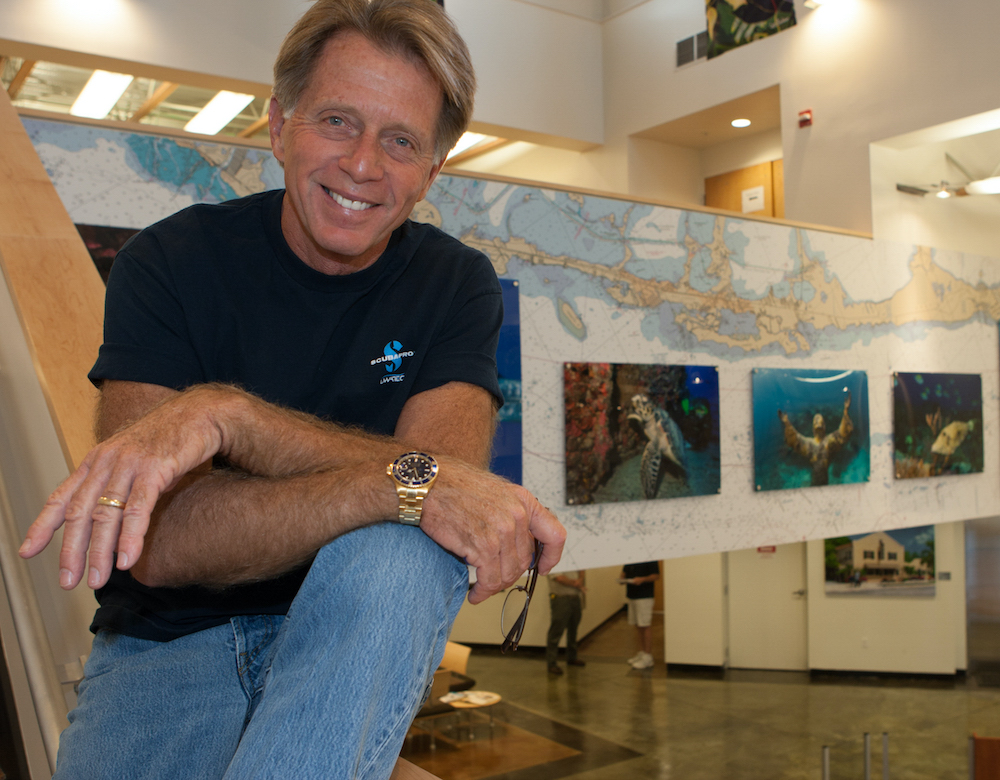Renowned photojournalist Stephen Frink just might be the planet’s most prolific published underwater photographer. He says he may never outgrow the “yondering years” of his 20s, living in California, Hawaii and Colorado before landing in the Upper Keys.

Stephen Frink’s work has taken him around the globe to photograph the underwater world and its inhabitants.
WaterHouse Tours, his travel company focused on dive excursions and underwater photography, enables Stephen to “yonder” to the world’s most remote and exotic destinations.
Yet home is Key Largo — which he calls “so astonishing” because of its incredible marine life population, offshore reef and legacy marine conservation restrictions such as “no-take zones” where fishing isn’t allowed.
A native of Rock Island, Illinois, Stephen became dive certified for a part-time job scraping barnacles off yacht hulls. He subsequently had photography-related jobs in Hawaii and Colorado.
In the late 1970s, he journeyed to Key Largo to visit a buddy who moved there to dive for sunken treasure.
Stephen is grateful he discovered Key Largo and its abundant marine life during a “sweet spot in time” when dive gear and cameras were sophisticated enough and the environment pristine.
“Scuba diving allowed me to explore, and cameras allowed me to record. I’ve had the best of it,” he said.
Each June since the early 1980s, Stephen has taught underwater digital imaging master classes for skilled photographers and divers. In 2016 he received the Academy of Underwater Arts and Sciences Award — considered the Oscar of the ocean world.

Stephen hopes that by depicting the beauty of the reef, he can help others gain a deeper appreciation of it.
Keys Voices: When did you first come to the Florida Keys and why?
Stephen Frink: I came on holiday to visit a buddy from our swim team when we were kids. He was working as a treasure diver, salvaging wrecks of the 1733 Spanish fleet. I went diving and saw not only beautiful reefs, but all the tourists diving here. Assuming there had to be a sizable population of underwater photographers among them, I thought I could serve them by renting cameras and processing slide film. In the fall of 1978, I loaded up my Chevy van and rolled into Key Largo from Colorado.
KV: What aspects of the Keys environment or way of life matter most to you?
SF: The marine life and coral reef. It’s astonishing to me, even now, that only 6 miles offshore we have a diverse and vibrant underwater ecosystem. Key Largo, in particular, comes from a long legacy of protection beginning with John Pennekamp Coral Reef State Park. Our marine protected areas’ no-take zones are brilliant concepts, serving as both nursery and aquarium.
KV: Who or what inspired you to become passionate about respecting and protecting the Keys’ natural world?
SF: South Carysfort, and photos by Jerry Greenberg of that region in decades preceding my arrival, were an epiphany. Carysfort is a long boat ride from the south end of Key Largo where I did most of my diving, so I didn’t get up there too often. But I did see the amazing fields of elkhorn and staghorn corals that Jerry immortalized in a National Geographic magazine article on Pennekamp Park in 1963. (When) I went there, the reef was in sharp decline. To realize that in less than a decade the reef could profoundly deteriorate made me appreciate how important it is to enjoy every dive, every time.
KV: How does that passion influence your work or profession?
SF: I’ve always wanted my underwater photography to inspire an appreciation of the coral reef. We protect what we love. I hope my images might educate and inspire. Shortly after I began my career in Key Largo, I was invited to shoot for dive magazines of the day. I realized I couldn’t get my photos published without writing articles to support them. Developing those skills made me very active with Sport Diver, Skin Diver and Scuba Diving magazines as a freelance photojournalist. For the past decade, I’ve been publisher of Alert Diver, an upscale quarterly magazine about diver safety and lifestyle, for the Divers Alert Network.
KV: What are some of the ways, personally or through your work, that you connect with and/or help protect the local environment and unique lifestyle?
SF: I serve on the board of directors for the Coral Restoration Foundation and Florida Keys National Marine Sanctuary Foundation. However, my most enduring local contribution likely is assisting with the acquisition and sinking of large artificial reef projects — the Bibb, Duane and Spiegel Grove — that have been so successful off Key Largo.
KV: What keeps you energized, challenged and focused on your path?
SF: The underwater environment is ever-changing. It is challenging to photograph it in a way that’s different — and hopefully better — than ever before.
KV: What message do you want your actions and example to communicate to people you encounter?
SF: It would be a cliché to say “take only photos, leave only bubbles,” but I’ll indulge myself this once.
KV: What’s your favorite natural or eco-friendly activity in the Keys?
SF: Scuba diving and underwater photography. That should be no surprise!


